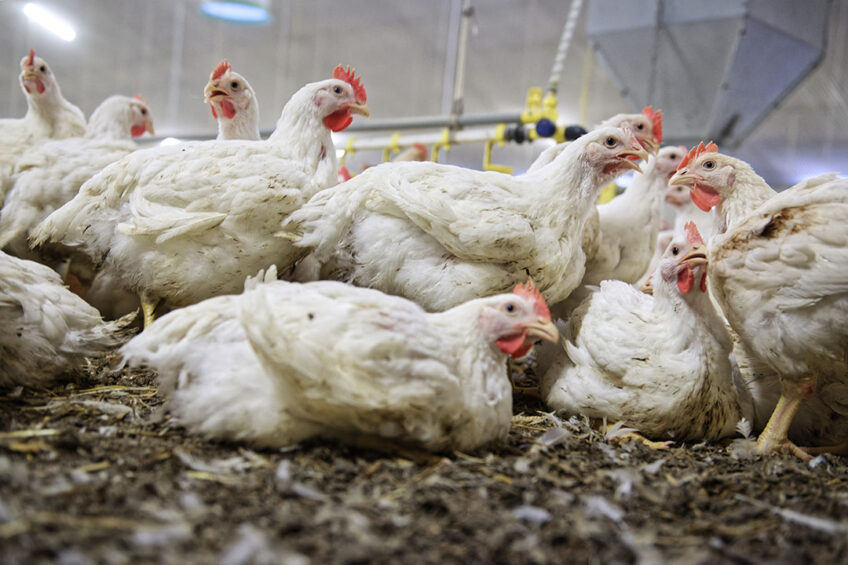Defend healthy broiler production in the UK

Delegates were pleased to finally catch up face-to-face for the first time in 3 years at the South West Chicken Association conference where welfare issues took centre stage.
Avian influenza and an unusual Enterococcus outbreak on both broiler and layer farms have led to major headaches for UK producers, with major welfare implications for the birds. With nearly 100 confirmed outbreaks of H5N1 avian influenza in the UK, vets believe the virus is now endemic and the country will have seasonal wave outbreaks.
Ben Crisp, senior vet at St. David’s Poultry Team, said the presence of the virus across many species of migrating wild birds meant that farmers would have to get used to the presence of the virus. Turkey farmers seem to have been particularly severely hit over the winter, where producers had often faced mortality rates of 100%. Crisp went on to document his investigations of leg issues in broilers caused by Enterococcus that had hit farms and breeds, including Ross and Hubbard, across the UK. Enterococcus is commonly prevalent in the gut, like E. coli, but it seems to have escaped and got into broiler joints.
Examining practices
Investigations into where the problems might have started have included the examining practices in hatcheries, brooder units and broiler farms without reaching significant conclusions, despite additional help from the government’s Animal and Plant Health Agency (APHA). Crisp said the problems manifested themselves on day 13 and had caused mortality rates of up to 20% on some farms. “Farmers had no idea at day 5 that birds would go down with this from day 13,” he said.
Antibiotics…they weren’t effective…
Antibiotics have been used and although this held the infection at bay for 4-5 days, they weren’t effective. They provided temporary relief for hard-pressed poultry workers having to deal with high mortality rates but the only thing that has proved effective has been using Lincospectin in a high dose. With no link to any breed, hatchery or parent flock, Crisp believes that water hygiene may be at least a contributory factor to the outbreaks. “Make sure your water is clean and don’t assume the system is working,” he told delegates.
Beyond the Five Freedoms
David Neilson, Avara Foods’ director of agriculture, spoke about the increasing trend towards looking at a range of welfare issues that go far beyond the Five Freedoms and now included in-depth analysis of mortality rates, Dead on Arrival (DoA), hock burn and pododermatitis rates and, increasingly, behaviour issues, too, around perching and dust-bathing, for example. With the government keen to make broiler journeys more comfortable, greater concentration on transport times was inevitable.
Neilson said welfare issues would continue to grow and change as digital technology spread across the sector. He believed the physical welfare audit carried out by Red Tractor will go online, so it was vital farmers embraced digital technology. Farmers need to follow Red Tractor’s ‘Every Standard Every Day’ policy, adding that the industry needed to defend healthy broiler production, which was welfare-friendly. But he warned, “we can only defend the defensible – being exposed causes a huge amount of anxiety.”
Welfare trials
Neilson spoke of two Avara welfare trials that have been taking place over the past year. One looked at the benefits and drawbacks of hatching on-farm versus hatching in hatcheries. Avara wanted to compare welfare in different systems and the extensive trial involved 4.5 million eggs in each option. Results showed hatching from a hatchery produced more tonnes per live weight than an on-farm hatchery but on-farm hatcheries had better DoA figures. Very low levels of pododermatitis were found in either setting, while dry litter was evident in both options.
Avara employed an independent vet to visit farms right through the cycle, who didn’t find high levels of stress. Cortisone levels were monitored in birds and both broilers born in hatcheries and on-farm were found to have low stress levels. Birds hatched on-farm were marginally more expensive for the producer as they had to feed them for slightly longer – costing 1p/kg (US$ 0.013/kg) extra but this was not key, although grading birds on farms was seen to be harder than in hatcheries.
The second trial was around breed evaluation looking at behaviour traits and stocking densities and was overseen by the University of Nottingham. There were three options: standard bird – Ross 308, slower-growing Hubbard Redbro and slower-growing Hubbard JA787.
Results
The Hubbard Redbro bird did have welfare and behavioural benefits compared to Ross 308. JA787 had no consistent benefit over Redbro but had a greater impact on the environment and affordability. Birds in 34kg/m2 showed behavioural benefits compared to those housed at 38kg/m2 rates in all breeds. But birds raised at 30kg/m2 had no benefits over 34kg/m2 but there was again a greater impact on the environment and affordability. Neilson said this was interesting in relation to the Better Chicken Commitment rate of 30kg/m2. “If consumers want to pay for the extensively reared bird, I have no problem but it doesn’t solve the carbon footprint issue.”
Patrick Nicholls, sales and technical manager for Hubbard UK and Ireland, said the BCC sector was growing with most French retailers and food service sectors moving towards it, along with Italy, Belgium and the Netherlands. Rabobank expects the EU market to be between 8-20% BCC by 2026. Nestlé and Nandos have become the latest two companies to announce a move to the BCC standards and 2 Belgian supermarkets are to ban all broilers.













